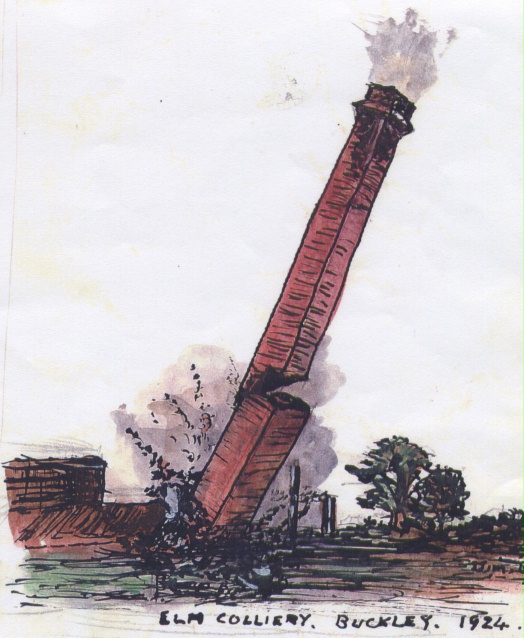
An Industrial and Pottery walk round Buckley - Numbers 24, 25, 26 and 27"

Elm Colliery, Buckley
3 September 1933
see entry 1.239
{James Bentley's note: Elm Chimney felled 3rd September 1933. On 12th May 1934, the Elm Colliery ceased winding.}
AN INDUSTRIAL AND POTTERY WALK ROUND BUCKLEY - NUMBERS 24, 25, 26 and 27
24. Retrace steps to the crossroads. Derelict buildings in a deep hollow on the left mark the site of Edward Parry's Ewloe Barn Brickworks. This firm specialised in dark blue engineering bricks, linings for boilers and cement kilns. They also made tiles for stable floors and railway platforms. On the right hand side of the lane is the Elm industrial estate. This was the Elm Colliery owned by the Buckley Colliery Company Limited. They worked another large colliery in Buckley known as the Mountain Colliery as well as numerous small concerns. Most pits were named after a tree. Examples: ash, oak, willow. A large circular concete slab on the forecourt covers the number three pit shaft of Elm Colliery, and it is 1,000 feet deep. A ruinous brick shed nearby was the powerhouse for the works when they became the first colliery in the country to use electric power for winding machinery in 1922.
Continue back up towards Buckley as far as the crossroads at the Pinfold industrial estate.
25. Turn right and immediately on the north (right) side is a single-storied white-washed cottage. It was the pottery of Thomas Lewis, senior (18th century). Old maps show the kiln to lie due south under the modern road. This is one of the many single-storied cottages which may be seen on the common. Many have now been modified or extended. In the 18th century, several were the abode of potters.
26. Continuing along this lane, known as White Farm Road, we pass through the area known as "The Willow". On the left in 2002 is a recently cleared area which was the site of Powell's Pottery, Green Meadows Laundry, Wolsey Holdings Ltd, Lithgow-Sakaphaen. (see entry 12.2 for photo 1955). Prior to being called Powells' Pottery, it was called Ewloe Pottery. Clay pits and hummocks in the surrounding common can be traced nearby. Powell introduced revolutionary techniques of potting compared with his neighbours. He also introduced the manufacture of "Devon Ware" type of objects. They carried notices written in sgraffito in their sides.
27. On the opposite side of the road is White Farm. This house bears a fireplace lintel with a date imprinted on it. During the 18th century it was in the possession of a Mr Leach who sold pot clay to the potteries. At a point where this road joins Alltami Road may be seen shallow ponds on the right. Descending, rectangular outlines are the site of clay drying pans. A little lower, toward the Tavern pub, on the opposite side of the road was Taylor's pottery. A flat circular platform marks the site of a kiln, the base of which was used until fairly recently as a pig sty. A small rectangular brick building at the entrance to the yard was the original offices.
Author: Bentley, James
Tags
Year = 1933
Month = September
Day = 3
Building = Industrial
Landscape = Industrial
Work = Heavy Industry
Extra = 1930s
Extra = Visual Arts
Copyright © 2015 The Buckley Society